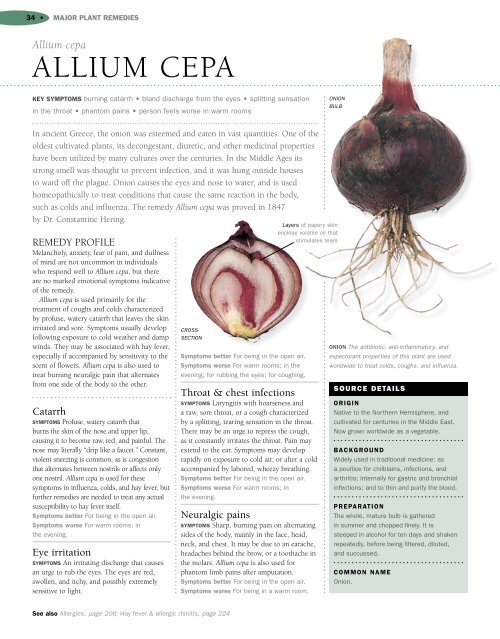Encyclopedia of Homeopathy
Encyclopedia of Homeopathy
Encyclopedia of Homeopathy
Create successful ePaper yourself
Turn your PDF publications into a flip-book with our unique Google optimized e-Paper software.
34 •MAJOR PLANT REMEDIESAllium cepaALLIUM CEPAKEY SYMPTOMS burning catarrh • bland discharge from the eyes • splitting sensationin the throat • phantom pains • person feels worse in warm roomsONIONBULBIn ancient Greece, the onion was esteemed and eaten in vast quantities. One <strong>of</strong> theoldest cultivated plants, its decongestant, diuretic, and other medicinal propertieshave been utilized by many cultures over the centuries. In the Middle Ages itsstrong smell was thought to prevent infection, and it was hung outside housesto ward <strong>of</strong>f the plague. Onion causes the eyes and nose to water, and is usedhomeopathically to treat conditions that cause the same reaction in the body,such as colds and influenza. The remedy Allium cepa was proved in 1847by Dr. Constantine Hering.Layers <strong>of</strong> papery skinenclose volatile oil thatREMEDY PROFILEMelancholy, anxiety, fear <strong>of</strong> pain, and dullness<strong>of</strong> mind are not uncommon in individualswho respond well to Allium cepa, but thereare no marked emotional symptoms indicative<strong>of</strong> the remedy.Allium cepa is used primarily for thetreatment <strong>of</strong> coughs and colds characterizedby pr<strong>of</strong>use, watery catarrh that leaves the skinirritated and sore. Symptoms usually developfollowing exposure to cold weather and dampwinds. They may be associated with hay fever,especially if accompanied by sensitivity to thescent <strong>of</strong> flowers. Allium cepa is also used totreat burning neuralgic pain that alternatesfrom one side <strong>of</strong> the body to the other.CatarrhSYMPTOMS Pr<strong>of</strong>use, watery catarrh thatburns the skin <strong>of</strong> the nose and upper lip,causing it to become raw, red, and painful. Thenose may literally “drip like a faucet.” Constant,violent sneezing is common, as is congestionthat alternates between nostrils or affects onlyone nostril. Allium cepa is used for thesesymptoms in influenza, colds, and hay fever, butfurther remedies are needed to treat any actualsusceptibility to hay fever itself.Symptoms better For being in the open air.Symptoms worse For warm rooms; inthe evening.Eye irritationSYMPTOMS An irritating discharge that causesan urge to rub the eyes. The eyes are red,swollen, and itchy, and possibly extremelysensitive to light.CROSS-SECTIONSymptoms better For being in the open air.Symptoms worse For warm rooms; in theevening; for rubbing the eyes; for coughing.stimulates tearsThroat & chest infectionsSYMPTOMS Laryngitis with hoarseness anda raw, sore throat, or a cough characterizedby a splitting, tearing sensation in the throat.There may be an urge to repress the cough,as it constantly irritates the throat. Pain mayextend to the ear. Symptoms may developrapidly on exposure to cold air, or after a coldaccompanied by labored, wheezy breathing.Symptoms better For being in the open air.Symptoms worse For warm rooms; inthe evening.Neuralgic painsSYMPTOMS Sharp, burning pain on alternatingsides <strong>of</strong> the body, mainly in the face, head,neck, and chest. It may be due to an earache,headaches behind the brow, or a toothache inthe molars. Allium cepa is also used forphantom limb pains after amputation.Symptoms better For being in the open air.Symptoms worse For being in a warm room.ONION The antibiotic, anti-inflammatory, andexpectorant properties <strong>of</strong> this plant are usedworldwide to treat colds, coughs, and influenza.SOURCE DETAILSORIGINNative to the Northern Hemisphere, andcultivated for centuries in the Middle East.Now grown worldwide as a vegetable.BACKGROUNDWidely used in traditional medicine: asa poultice for chilblains, infections, andarthritis; internally for gastric and bronchialinfections; and to thin and purify the blood.PREPARATIONThe whole, mature bulb is gatheredin summer and chopped finely. It issteeped in alcohol for ten days and shakenrepeatedly, before being filtered, diluted,and succussed.COMMON NAMEOnion.See also Allergies, page 206; Hay fever & allergic rhinitis, page 224
















